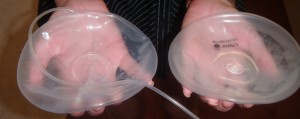 I see numerous patients these days who are interested in replacing their aging saline implants. While some choose to place new saline implants, many are interested in switching to silicone. There are several motivations for the change, but here are a few:
I see numerous patients these days who are interested in replacing their aging saline implants. While some choose to place new saline implants, many are interested in switching to silicone. There are several motivations for the change, but here are a few:
1. Deflation The original procedure was done when silicone was not generally available. Now some women may find that their saline implants are leaking or deflated and they wish to take the opportunity to "upgrade" to silicone. In some cases, their saline implant may have a warranty which can be used to help defray the cost of the revision surgery.
2. Desire to Change Size Some younger patients may have had implants that were just too small and want to move to a larger implant. Conversely, middle-aged patients may find that their native breast tissue is increasing as they gain weight later in life. This makes their overall breast size too large and they are frequently interested in downsizing their implants.
3. Better Quality Implant Over the years, the rippling that accompanies saline implants can get worse, and motivate patients to move to silicone to diminish this problem. This is especially true in patients who have textured saline implants, which are particularly prone to rippling.
4. Malposition The most common, long-term problem with saline implants is that they stretch out the patient's breast tissue and the implant ends up too low and too far out to the side. This is most bothersome to patients whose original motivation for the procedure was to restore fullness in the upper part of their breasts. With stretching of the lower part of the breast, patients lose their upper breast volume and end up having the same, "droopy" shape they started with, only now they are bigger.
With stretching of the side of the breast, patients notice migration of their implants to the side (or even off their chests) when they lie down. Problems related to stretching of the breast from saline implants can usually be treated with revisional surgery and conversion to a silicone implant. Because silicone is "thicker" or more viscous than saline, there is considerably less tendency for the implant to stretch the patient's breast. As a result, the implant position is much more stable over time.
No matter what the motivation, very few patients who change to silicone regret their choice. If you are dissatisfied with the results of your saline augmentation, consider changing them to silicone.